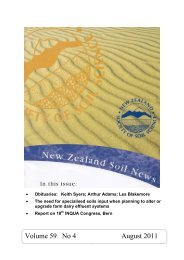Volume 55 No 2 April 2007 - New Zealand Society of Soil Science
Volume 55 No 2 April 2007 - New Zealand Society of Soil Science
Volume 55 No 2 April 2007 - New Zealand Society of Soil Science
You also want an ePaper? Increase the reach of your titles
YUMPU automatically turns print PDFs into web optimized ePapers that Google loves.
Denitrification capacity in the vadose zone at three sites in the Lake<br />
Taupo catchment, <strong>New</strong> <strong>Zealand</strong><br />
Greg Barkle A , Tim Clough B , and Roland Stenger C<br />
A Corresponding author. Aqualinc Research Ltd, PO Box 14-041, Hamilton, <strong>New</strong> <strong>Zealand</strong>. Email:<br />
G.Barkle@Aqualinc.co.nz<br />
B Agriculture & Life <strong>Science</strong>s Division, PO Box 84, Lincoln University, Lincoln, <strong>New</strong> <strong>Zealand</strong>.<br />
C Lincoln Environmental Research, Private Bag 3062, Hamilton, <strong>New</strong> <strong>Zealand</strong>.<br />
Land use in the Lake Taupo catchment is under scrutiny, as early signs <strong>of</strong> deteriorating water quality<br />
in Lake Taupo have been observed. Although the fate <strong>of</strong> contaminants in soil and groundwater are<br />
comparatively well studied, the transformations in the lower vadose zone, i.e. the zone between the<br />
soil and the groundwater, are less well understood. The capacity for NO3-N removal via biological<br />
denitrification, based on utilising the resident C substrate, in the vadose zone <strong>of</strong> the Lake Taupo<br />
catchment is quantified in this work. Complete vadose zone pr<strong>of</strong>iles were sampled at 3 sites<br />
(Rangiatea, Waihora, and Kinloch), from the soil surface down to the watertable in approximately 0.5-<br />
m depth increments. Texture, allophane content, pH, and concentrations <strong>of</strong> extractable NO3-N, NH4-<br />
N, and dissolved organic carbon were determined. Incubations were undertaken to determine the<br />
denitrification capacity <strong>of</strong> the vadose zone materials amended with NO3-15N, but no added carbon<br />
substrate, and maintained under anaerobic conditions at 28°C. Gas samples were taken from the<br />
headspace after 48 h and analysed for N2 and N2O. In soil depths down to about 1.2 m, the<br />
denitrification capacity ranged from 0.03 to 9.18 kg N/ha.day, and below this depth it ranged from<br />










